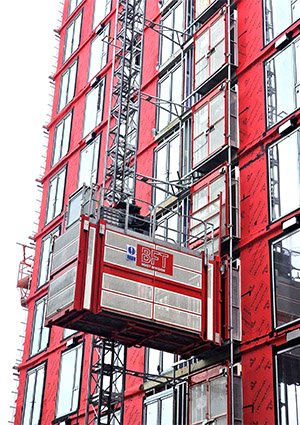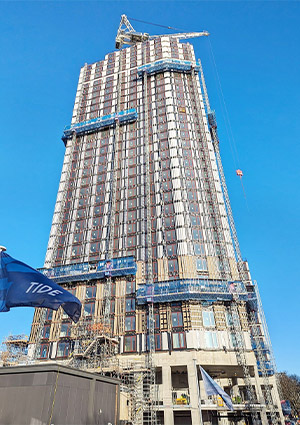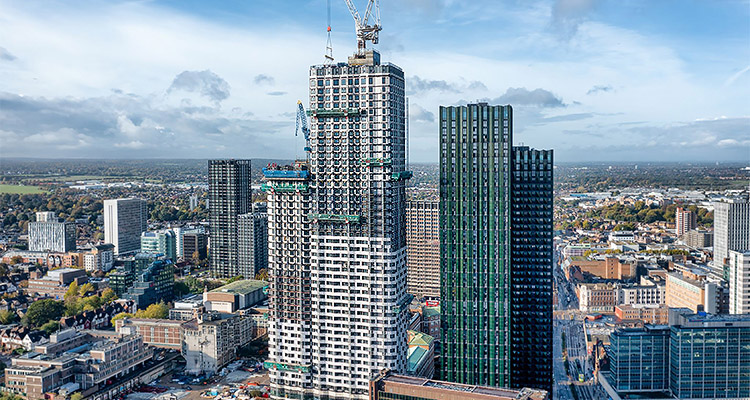Delivering unmatched speed, flexibility, and safety, BFT Mastclimbing combines advanced technology with cost-saving solutions
Boasting the UK’s youngest fleet of mechanical motorized MastClimbing Work Platforms (MCWP), BFT Mastclimbing offers a cost-effective, innovative alternative to traditional scaffolding. The company is built on over 20 years of experience in the construction and civil engineering industry, as Chief Executive Officer, Andrew Perry, begins: “BFT stands for Board Fittings and Tubes, a name that harks back to when the business started – boards, fittings, and tubes are some of the products used in scaffolding. The business began as a scaffolding, hire, sales, and contracting operation. It started out in 1997 and operated on a small scale for several years.
“Early in the company’s tenure, it was assigned to a scaffolding gantry project in Luton. The owners at the time noticed that the project used mastclimbers to access the outside of the building – they became interested in this innovative new product and sought out the providers. The operators were from Scotland, and while they had expertise in mastclimbing, they were struggling with their logistics operations. Getting the product from Scotland, down to Luton, was proving a challenge. The owners of BFT saw this as an opportunity to get some mastclimbers for themselves, and bring mastclimbing into new territories.
the outside of the building – they became interested in this innovative new product and sought out the providers. The operators were from Scotland, and while they had expertise in mastclimbing, they were struggling with their logistics operations. Getting the product from Scotland, down to Luton, was proving a challenge. The owners of BFT saw this as an opportunity to get some mastclimbers for themselves, and bring mastclimbing into new territories.
“At the next opportunity the owners bid for a project using mastclimbers, and although at the time they had no stock a project was won, and mastclimbers were procured. The first job was a success, and so was the second – soon, mastclimbing became the primary service offering of BFT and scaffold contracting became a thing of the past.
“Today, we predominantly provide mastclimbing work platforms. We are the largest single stockholder of mastclimbers in the country, maybe Europe. On top of these, we have some construction hoists, which are suitable for a variety of applications to complement our offering.
“Our fleet consists of 1600 mastclimbing driver units, spread across four different equipment sizes. The smallest unit we provide is a lightweight model known as the BFT90. This is a compact machine that can be manoeuvred by two people. It’s perfect for fitting into smaller, more confined spaces. For example, it’s been used to do work in lift shafts and on canal towpaths, where traditional scaffolding simply won’t fit. Then, we’ve got the BFT120, and the BFT130. These are our core machines. They’re very flexible and hard-working pieces of equipment. They can carry a significant load, and the 130 is especially versatile, meaning we can adapt it to suit different applications and apply innovation. This gives us more flexibility and allows us to use these machines on a wider variety of projects.
“Finally, we have the BFT150. The 150 is our biggest machine. This is used primarily on heavy duty projects, where the materials are heavy, and the project is usually operating on a much larger scale. Our fleet is varied enough that it suits the requirements of almost any building project – and when a customer approaches us, we’re able to give expert advice as to which models would be best for the job. In addition, as if our fleet wasn’t already working hard enough, it’s also helping us in our philanthropic work. All our 130 machines are painted pink, and for every unit that goes on hire we contribute toward breast cancer awareness through Cancer Research UK. Equally all of our 150 machines are red, and we contribute to the Lighthouse Foundation.
 “Our machines and our staff are the core of our business and services we offer. Everything is maintained to an impeccable standard and supplied by European manufacturers. We buy brand-new, and the entire fleet is owned by BFT Mastclimbing. We also have our own fleet of specialist vehicles, which we operate alongside the mastclimbers. The machinery is delivered to site, with a BFT driver to pick up or drop equipment off. Our drivers are all trained to deliver equipment using HIAB attachments. In total, we operate eight Heavy Goods Vehicles (HGVs) for transportation and delivery purposes. On top of that, we operate a number of smaller vehicles for our installers and engineers to use. All equipment is prepared, delivered, erected, adapted and dismantled by BFT personnel.”
“Our machines and our staff are the core of our business and services we offer. Everything is maintained to an impeccable standard and supplied by European manufacturers. We buy brand-new, and the entire fleet is owned by BFT Mastclimbing. We also have our own fleet of specialist vehicles, which we operate alongside the mastclimbers. The machinery is delivered to site, with a BFT driver to pick up or drop equipment off. Our drivers are all trained to deliver equipment using HIAB attachments. In total, we operate eight Heavy Goods Vehicles (HGVs) for transportation and delivery purposes. On top of that, we operate a number of smaller vehicles for our installers and engineers to use. All equipment is prepared, delivered, erected, adapted and dismantled by BFT personnel.”
Multiple benefits
Mastclimbing equipment offers numerous advantages over traditional scaffolding, as Andrew discusses: “The benefits are so simple we put them on the side of our vans in our logo ‘faster safer cheaper’. Compared to traditional scaffolding, what can take 24 days to put up takes just a few days for the equivalent, with significantly less men, materials and transport involved. Because of the way the machines work, there’s significantly less impact in terms of transport, meaning there’s less vehicles coming to site. This makes the overall project more sustainable and provides faster access for the people using the equipment and that is before we consider the client savings from an accelerated build or reparation program.
“They are also equally as flexible as scaffolding. Mastclimbers are suited to most building projects, and we can adapt our machinery if needed. A lot of our work is centred on remediation, meaning the buildings are often occupied. Contractors find that our machines are much less obtrusive to residents, as they do not obstruct sunlight, obscure people’s view, or remain in the same position on the building for extended periods. It’s also a benefit in terms of safety. Scaffolding can compromise the security of a building, but that is much less likely with a mastclimber which lowers to the ground at the end of each day and with power removed cannot move. The safety records for mastclimbers across the UK are also very good – much better than the numbers recorded on sites that use traditional scaffolding.
“For those operating the machinery, they can be assured that there are up to eight braking systems that will hold the mastclimber in place. Furthermore, it’s always at the right level, so bricklayers can work at optimum height, reducing the risk of injury when reaching upward or bending down. Everything is constantly at the level you need it to be.
Future goals
“Finally, we offer a financially viable alternative to traditional scaffolding, with our services costing, on average, 30 percent less than industry equivalents. We quote based on the full project, meaning not only do we offer an end-to-end service, but there’s no hidden costs. The machinery is intuitive and adaptable, and it’s very rare we need to extend a project or provide additional assistance.”
With two decades of success under its belt, BFT Mastclimbing continues to prove the power and endurance of motorized mastclimbing technology. Looking toward the future, Andrew considers what’s next for the business: “In the long-term, I’d like to think that we’ll be operating a larger fleet of over 2000 mastclimbers. In addition, I’d like to see our turnover exceed £25 million within the next five years. We currently operate from two depots, with a third soon to be up-and-running. A larger footprint, I believe, will go a long way in achieving our goals,” he concludes.
